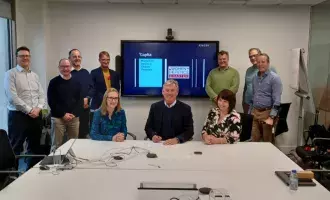The effects of digitisation go way beyond the private sector.
Deloitte's insight report shows the tide may well be turning for local government and cloud[i], with LGOs now well poised to realise the potential of cloud through 2020 and beyond.
Cloud is no longer simply about delivering new infrastructure for applications. It’s about the promise of improved experiences for your citizens – and better productivity outcomes for you.
Today’s customers and citizens expect more and more services to be delivered to them digitally – and local government services are no exception. In the next few years, LGOs will need to be ready to meet those expectations, offering urban and rural citizens intuitive access to automated public services.
The vision of smart citizen services is not new. Smart cities all run from cloud, leveraging innovative digital technologies to enhance the way communities live, work and grow. Advances in everything from street lighting and traffic flow to refuse collection, public safety, air quality monitoring and much more are being enabled by emerging technologies such as IoT, AI, machine learning and RPA.
The next wave of cloud migration in local government will further develop these services – while failure to innovate will mean citizens and local businesses could get left behind.
Smart City solutions are leveraging public cloud services to address some key goals, including:
- improving the way urban centres operate
- enhancing citizen experiences
- supporting the economy
- managing and growing infrastructure
- connecting residents, visitors and businesses
- democratising citizen engagement and tackling the digital divide.
For the LGOs themselves there is the additional promise of improved efficiencies and revenue generation – as well as the chance to redress service issues, simplify processes and ease citizen frustration. And the benefit of freeing up staff to add greater value to citizen interactions – or focus on more strategic tasks – speaks for itself.
Digital is rewriting the rules of citizen engagement. The range of potential applications for LGOs is huge – council tax, social housing, care in the community, planning permission, accounts, customer services – and more. Very soon, the transformative benefits of cloud will be a no brainer, rather than a nice to have. LGOs will be expected to demonstrate their ability to harness innovation, delivering smarter, safer, more engaging services for every citizen.
For example, Robotic Process Automation (RPA) can offer a vital revenue growth stream for council tax – by automating time-consuming activities and maximising output in a flexible, easy-to-scale way. Other councils have successfully smoothed the adoption of the new Universal Credit claims process through automation.
Cities everywhere are reporting huge time and cost savings in everything from smart street-lighting to water supplies, optimised traffic flow and smart waste management.
And they’re changing lives. A McKinsey report found that smart city initiatives can improve quality-of-life indicators by up to 30%[ii]. And many digital leaders consider technologies such as IoT to be critical to that success[iii].
If there’s one ingredient you can’t do without to build the smart city – it’s a model of continuous innovation.
Building an innovation mindset – the importance of leadership
In any successful transformation, change comes from the top. Today’s CIO has a clear role to play in communicating a transformative vision, and driving digital strategies that deliver it. In some organisations the role has been split into a traditional CIO who focuses on keeping the lights on – and a CDO who focuses purely on digital strategy and vision.
However you manage the role, the skills needed for digital transformation will be very different to the technical approach you’ve traditionally relied on. Much of this is down to the nature of digital transformation itself.
For a start you need to cultivate a culture of collaboration, by heading up the innovation roundtable. You’ll be expected to open up conversations between people from different backgrounds, with diverse skillsets and professional objectives.
You’ll need the ability to deliver critical projects, to communicate your vision with clarity, and to challenge your teams to engage further, think more deeply and deliver better outcomes.
You may find you need to adapt your traditional top-down communication approach and adopt a more flexible, interactive approach to bring your digital initiatives to life.
And, most of all, you’ll need to step into a more visionary, leadership role; showing that you can stay at the helm, keep your eye on the horizon, and slowly but surely guide the ship forwards.
Finding the finance
One of the difficulties with financing innovation is quantifying it – and calculating how much you’ll need. Our recommendation is to ringfence and guarantee a special innovation fund – distinct from your day-to-day IT budget.
This way there is a common understanding from the outset that an innovation pot can be tapped into for spinning up proof of concept labs to trial new cloud services as and when required. It’s important to ensure innovators can do so freely without disrupting investment in normal IT operations.
Finding the right partner
To help you on your digital journey, you need a partner that does much more than simply lift and shift IT workloads. You need that rare quality of a partner who can optimise your new cloud estate, keep in step with the latest cloud innovation, and then work with you to apply it against your specific digital goals.
This is a critical consideration for cloud adoption success. So take your time – and choose well.

Wasif Afghan
Head of Product for Cloud, Capita Technology Solutions
Highly experienced IT product leader. Currently head of product for cloud and platform, also covering strategy and propositions. Subject matter expert in cloud, data centre, digital transformation and IT services markets. Track record of success stretching back more than 20 years at IT systems integrators, telcos and cloud-specialist managed services providers.







